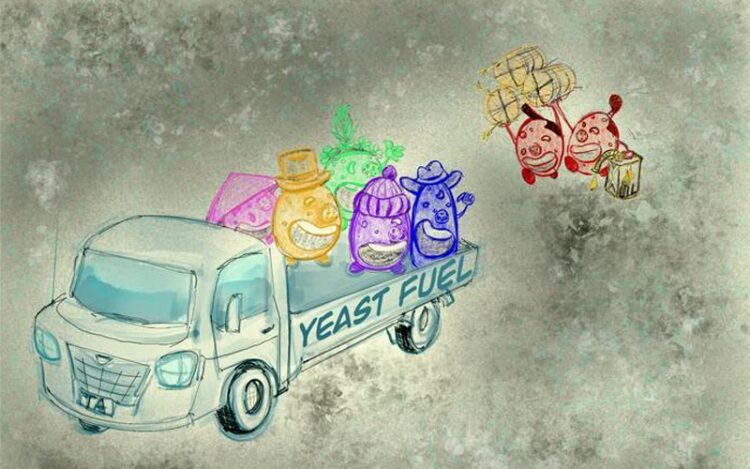Two-of-a-kind strike oil

The similar composition of vegetable oils to lipids makes this type of yeast a possible alternative to petroleum diesel fuel.
Credit: KyotoU Jake Tobiyama/Ayumi Tanimura
Discovery of oil-forming yeast species boosts hope for reducing carbon dioxide emissions.
Not all yeasts are created equally. Unlike the yeast used by bakers and beer brewers for converting sugars to carbon dioxide and fermentation, oleaginous yeasts convert sugars from inedible biomass into fats and oils.
A research group jointly led by Kyoto University and Ryukoku University has discovered two new species of oil-forming yeast in the soil of Shiga Prefecture. Their study also examines the relationship between the prefecture’s diverse climate and microbial ecology.
“We are gauging the potential benefits of applying oleaginous yeast to sustainable oil and fat production through isolation technology, particularly in reducing carbon dioxide emissions,” says team leader and first author Ayumi Tanimura of KyotoU’s Society Academia Collaboration for Innovation.
The discovery of two species — Hannaella oleicumulans, named after its oil-accumulating properties, and Hannaella higashiohmiensis from Higashiomi City — suggest the high potential of microbial resources in this region. They join the roughly 160 species of known oil yeast, including the previously known Lipomyces starkeyi, Rhodotorula toruloides, and Yarrowia lipolytica.
The diversity of yeast species in Japan reflects the latitudinal range of the Japanese archipelago. Shiga prefecture’s diverse biomes — hydrosphere, forests, and arable land — and highly variable climate encourage this diversity. Tanimura promotes continuing efforts to search for new microbial resources in unexplored areas.
Focusing on the soil of Shiga Prefecture, Tanimura’s team conducted DNA analyses and physiological, morphological, and biochemical characterization tests that supported the identification of the two Hannaella species. Culture tests next verified them as oleaginous yeasts, which can take up xylose to produce oil from plant biomass such as rice straw.
At publication, approximately 160 species were reported as oleaginous yeast, producing more than 20% of their dry cell weight as lipids.
“However, since lipid content easily changes with changing conditions in culture, we may need to redefine the term oleaginous yeast,” notes Tanimura.
The similar composition of vegetable oils to lipids makes this type of yeast a possible alternative to petroleum diesel fuel.
“Having gained insight into the diversity of oilseed yeasts, we plan to test enhanced methods for obtaining new strains with higher oil and fat productivity or those that produce only specific fatty acids,” adds Tanimura.
The paper “Hannaella oleicumulans sp. nov. and Hannaella higashiohmiensis sp. nov., two novel oleaginous basidiomycetous yeast species” appeared on 20 September 2023 in International Journal of Systematic and Evolutionary Microbiology, with doi: 10.1099/ijsem.0.006027
About Kyoto University
Kyoto University is one of Japan and Asia’s premier research institutions, founded in 1897 and responsible for producing numerous Nobel laureates and winners of other prestigious international prizes. A broad curriculum across the arts and sciences at undergraduate and graduate levels complements several research centers, facilities, and offices around Japan and the world. For more information, please see: http://www.kyoto-u.ac.jp/en
Journal: INTERNATIONAL JOURNAL OF SYSTEMATIC AND EVOLUTIONARY MICROBIOLOGY
DOI: 10.1099/ijsem.0.006027
Method of Research: Experimental study
Subject of Research: Not applicable
Article Title: Hannaella oleicumulans sp. nov. and Hannaella higashiohmiensis sp. nov., two novel oleaginous basidiomycetous yeast species
Article Publication Date: 20-Sep-2023
COI Statement: The authors declare that there are no conflicts of interest.
Media Contact
Jake G. Tobiyama
Kyoto University
tobiyama.gakuji.6y@kyoto-u.ac.jp
All latest news from the category: Life Sciences and Chemistry
Articles and reports from the Life Sciences and chemistry area deal with applied and basic research into modern biology, chemistry and human medicine.
Valuable information can be found on a range of life sciences fields including bacteriology, biochemistry, bionics, bioinformatics, biophysics, biotechnology, genetics, geobotany, human biology, marine biology, microbiology, molecular biology, cellular biology, zoology, bioinorganic chemistry, microchemistry and environmental chemistry.
Newest articles
Humans vs Machines—Who’s Better at Recognizing Speech?
Are humans or machines better at recognizing speech? A new study shows that in noisy conditions, current automatic speech recognition (ASR) systems achieve remarkable accuracy and sometimes even surpass human…

Not Lost in Translation: AI Increases Sign Language Recognition Accuracy
Additional data can help differentiate subtle gestures, hand positions, facial expressions The Complexity of Sign Languages Sign languages have been developed by nations around the world to fit the local…

Breaking the Ice: Glacier Melting Alters Arctic Fjord Ecosystems
The regions of the Arctic are particularly vulnerable to climate change. However, there is a lack of comprehensive scientific information about the environmental changes there. Researchers from the Helmholtz Center…



